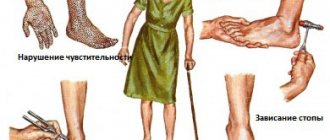Ignorance and widespread dissemination of false facts about diseases leads to the emergence of various fears in people. Speedophobia is one of these. Every year more and more men and women are afraid of contracting a dangerous pathology. Various factors lead to the development of phobias in them, which negatively affect their psycho-emotional state. To prevent the situation from becoming critical, you should promptly seek help from psychotherapists who help patients cope with the strong fear of AIDS.
Causes of speedophobia
Lack of basic knowledge about the disease - how it spreads and how to avoid it - can lead to a pathological fear of acquired immunodeficiency syndrome
Fear of AIDS belongs to a group of mental conditions that are collectively termed “hypochondriacal syndrome.” It is caused by a person’s constant worries about his or her health. People with such a mental disorder believe that they suffer from a disease that in reality does not exist.
Speedophobia affects people who are characterized by such personality traits as high suspiciousness and anxiety, impulsiveness and pliability to irritants.
Psychotherapists have learned to cope with hypochondriacal syndrome, which gives rise to a lot of phobic conditions. For their methods to work, the patient must independently want to cope with the pathology.
Experts have identified a number of reasons that can lead to fear of AIDS:
- The common belief is that this disease is incurable.
- The stereotype is that HIV patients die after a few years of illness.
- There are many unfounded myths regarding the development of AIDS.
- Lack of information about the disease and its prevention.
- Incorrect statistics on morbidity and mortality that relate to a pathological condition.
- Misinformation about AIDS in the media.
- The presence of nonspecific symptoms in the disease, which are also characteristic of more common pathologies.
- Wrong work of doctors.
- Social discrimination against patients who have received a disappointing diagnosis.
- Having a negative experience associated with the death of a loved one due to this disease.
Stressful situations can contribute to the development of speedophobia. With this disorder, certain symptoms of malaise occur. A suspicious person begins to perceive them as signs of the development of AIDS. Against this background, the experiences only begin to intensify, which is why the course of the mental disorder is greatly complicated.
Causes of fear of AIDS
Speedophobia is a type of hypochondriacal syndrome - constant worry about one’s health and the identification of all kinds of non-existent pathologies. The syndrome is typical for suspicious and anxious people, susceptible to the slightest irritants, excitable and impulsive, especially if one of their relatives and friends is sick. In modern medicine, hypochondria refers to reversible mental disorders, accompanied by changes in the functioning of somatic mechanisms. That is, there are no organic disorders, the cause of the disorder is feelings and emotions.
For a hypochondriac to develop speedophobia, it is enough to hear about the incurability of HIV and, for example, the first symptoms of the disease. In addition, there are many similar reasons for fear of AIDS:
- stereotype about the doom of HIV patients to suffering and quick death;
- a widespread prejudice that there is no cure for HIV;
- a large number of myths and fictions regarding AIDS;
- illiteracy and poor awareness of the population about the methods of transmission and prevention of HIV;
- exaggerated and distorted statistical data (HIV incidence, AIDS mortality);
- unreliable information from the media and the Internet about new methods of infection, a general epidemic, the creation of new strains of HIV in the laboratory and other fabrications of journalists that people with speedophobia perceive as truth;
- nonspecific signs of immunodeficiency - any cold or allergic rash is perceived as a manifestation of AIDS;
- incorrect work of doctors and lack of educational work;
- social aspect - discrimination against HIV patients and negative labeling - only drug addicts, homeless people and people who are promiscuous are affected;
- negative experience - someone close to you had HIV or died of AIDS.
Symptoms of pathological fear
Speedophobia and other similar painful conditions are often caused by the fear that medical workers will not comply with the requirements of medical ethics. Therefore, people who are confident in their fictitious illness do not try to turn to anyone for help. But in this situation, consultation with a psychologist is mandatory. This should be understood by every person who has identified symptoms characteristic of a mental disorder.
Mental and emotional symptoms
A person becomes overly suspicious of his health
A person’s fear of contracting AIDS is accompanied by the appearance of signs during attacks that he manages with great difficulty to hide from others. The development of a mental disorder can be identified by the following symptoms of illness:
- Increased attention to your own health and well-being. A person begins to panic even at the slightest deterioration in his condition. He perceives any illness as a sign of HIV and AIDS.
- Minor signs and symptoms force the patient to immediately go for tests to evaluate the health status. It is worth noting that negative results do not give people with speedophobia a feeling of relief. They simply begin to doubt their credibility. This state of affairs forces them to regularly visit the laboratory and undergo various tests.
- Regularly visiting the Internet to search for confirmation of the veracity of your guesses. If a person finds them, he feels temporary relief and satisfaction. At the same time, his fear intensifies.
- A patient with a phobia always remembers emergency numbers. He tries not to miss a single event dedicated to the topic of AIDS.
- A person susceptible to fear of a dangerous disease rarely trusts doctors’ statements that the diagnosis does not confirm his illness. This is one of the most striking symptoms of mental disorder.
If a person suffers from speedophobia, then he will be constantly worried about the possibility of contracting AIDS. When talking, he regularly mentions the disease and may complain about the presence of symptoms that indicate its development.
Physical ailments
Constant worries about HIV and AIDS, as well as the thought that a person can get sick by contracting a dangerous disease, leads to the appearance of somatic disorders. In fear for his own life, the patient begins to associate them with the signs of this pathology.
We must remember! Prolonged experiences and stress significantly worsen a person’s general condition. He blames this on the development of pathology, which in reality does not exist, which is confirmed by the results of numerous studies.
It is necessary to think about starting to fight speedophobia if a person periodically experiences the following symptoms:
- Constant weakness in the body.
- Headache.
- Increased body temperature
- Skin rashes.
- Poor health.
- Increased fatigue.
This symptomatology is considered by a person with speedophobia as another confirmation of the development of a dangerous disease.
Fear of contracting HIV is a natural reaction of a healthy person.
Speedophobia is a neurotic disorder that manifests itself in the form of fear of contracting HIV or AIDS. This phobia seriously affects a person's quality of life. He is nervous, anxious, but cannot get rid of this obsessive state on his own.
In most cases, anxious and impressionable people with a fragile psyche, psychological trauma, aged 20 to 30 years are at risk of developing this phobia.
The true causes of speedophobia have not yet been studied by modern medicine. But psychologists note a number of signs that manifest themselves in the behavioral and emotional spheres.
These include:
- Genetic predisposition . If a person’s parents or any of their relatives were or are carriers of HIV, then they may be haunted by the fear of contracting the disease themselves.
- A large amount of negative information in the media about the deadly danger of AIDS and the number of people affected by it. The topic of HIV is often discussed on the Internet, sparing no gruesome details. An impressionable person may take all this to heart and begin to be seriously afraid.
- Childhood psychotrauma. For example, one of the relatives or acquaintances died of AIDS, and this affected the child so much that even in adulthood the person could not overcome the fear of this disease.
- Wrong work of doctors. The person has been misdiagnosed before and is therefore worried that HIV will strike him. The common cold is considered deadly by them, and the manifestation of a chronic disease is regarded as a clear sign of immunodeficiency.
- Condition and symptoms of pseudoAIDS. Today, probably, almost each of us, if desired, can detect any “symptoms” of HIV. Chronic fatigue, rashes on the body, painful and enlarged lymph nodes can be mistaken for one of the symptoms of HIV.
- Feeling guilty for your actions , which could lead to the acquisition of HIV . For example, speedophobia can develop in married men who have had sexual contact on the side.
- A psychological disorder characteristic of homosexual men. After the next sexual contact, they experience an irresistible desire to get tested, because... they are convinced that an infection has occurred.
How to cope with speedophobia
You need to get rid of a mental disorder. To do this, first of all, you need to find out how to remove and how to get rid of speedophobia. Doing this on your own is quite problematic. Therefore, it is better to seek advice from a qualified specialist.
Psychotherapy
Exercising at the gym will help you take your mind off negative thoughts
The treatment of fear is based on psychotherapeutic techniques. They help patients see their problem and find its cause. This increases the chance of achieving sustainable results.
Without psychotherapy, a person will not be able to achieve full recovery and freedom from speedophobia. Working exclusively with an experienced psychotherapist allows us to reveal the true factors that cause strong fear of a dangerous disease.
Individual work is carried out with each individual patient who seeks help from a psychologist or psychotherapist. A group of different types of therapy is selected for the patient, which enhance the effect of each other during complex treatment. When choosing techniques, a specialist takes into account the set of personal qualities of a person and his abilities.
Good results in the treatment of speedophobia can be achieved with cognitive behavioral therapy. Family and positive (according to Rogers) type of psychotherapeutic treatment is also included. When dealing with a mental disorder, it is very important for a patient to enlist the support of loved ones. Therefore, the patient’s family and friends should also attend a couple of consultations with a psychologist to discuss the current problem.
During therapy, the patient should be limited in receiving information about AIDS, its characteristics and development. It is best to try to fill the head of a person with speedophobia with positive thoughts. Watching funny movies or TV shows with your family helps you cope with this task. Active sports and regular walks are also useful.
Medication method
Long-term refusal to treat a mental disorder contributes to its active progression. In such situations, it is not possible to limit ourselves solely to the use of psychotherapy methods. The course of treatment includes taking medications whose action is aimed at suppressing the symptoms of speedophobia.
Important! The attending physician prescribes the course of medication. Patients are prohibited from making their own decisions about taking certain medications to treat fear.
Antidepressants, sleeping pills, tranquilizers and psychostimulants help cope with the progression of speedophobia. Medicines must be combined with psychotherapy, since on their own they cannot suppress the activity of the fear of contracting a dangerous pathology.
According to statistics, in Russia every 40th man aged 25 to 40 is infected with HIV.
The number of HIV-infected men is increasing every year, including in the Kirov region.
Growth is usually associated with the following factors:
- men have more sexual partners than women;
- seek sex services more often;
- tend to abuse alcohol and drugs in combination with sex;
- have a high risk of infection through same-sex sexual contacts;
- rarely think about their health, especially reproductive health.
WHAT DO YOU NEED TO KNOW ABOUT HIV?
We know what computer viruses are and how to maintain the “health” of your electronic assistant, but what is HIV and how to maintain your health?
HIV is a human immunodeficiency virus that destroys the immune system. He cleverly bypasses the body’s defense systems, gets to the “command post” and, having captured it, forces the protective cells to produce viral copies. As a result, the immune system stops working. The body becomes vulnerable to infections and harmful environmental influences.
As a result, the disease, which is based on immunodeficiency, enters the final stage - AIDS (acquired immunodeficiency syndrome). At this stage, the immune system is so weakened that diseases that develop against the background of HIV infection lead to death.
HIV infection occurs in only three ways:
- sexual (any sexual contact without using a condom);
- through blood (through a non-sterile syringe/needle/drug container; through a non-sterile instrument when applying a tattoo/piercing; infection is possible if epidemiological safety rules for blood transfusions are violated);
- from mother to child (in utero, during childbirth, through breast milk).
THOSE WHO KNOW LITTLE ABOUT THE WAYS OF HIV TRANSMISSION ALWAYS RISK MORE!
The predominant route of HIV infection is sexual — at the end of 2018, about 70% of all cases of HIV infection detected in the Kirov region were due to unprotected sexual contacts.
Infection can occur through all forms of sexual contact. anal contact is especially dangerous
since this is the most traumatic type of sexual activity. The rectal mucosa contains cells that are susceptible to HIV, and if microtraumas appear on the mucosa, the risk of the virus entering the blood increases significantly. Therefore, the “passive” partner is at high risk of infection.
However, the “active” partner is also at risk, as he comes into contact with mucous membranes and blood.
The next highest risk is unprotected vaginal intercourse.
The likelihood of infection in this case increases with damage to the mucous membranes of the genital organs, during sexual contact during menstruation, in the presence of inflammatory diseases of the genitourinary system or infections.
During oral contact
the risk of infection is lower than with the first two forms, since the concentration of the virus in saliva is very low. However, if there is blood in the partner's saliva (due to damage to the oral mucosa), the risk of infection increases significantly.
THE GREATER THE NUMBER OF SEXUAL PARTNERS, THE HIGHER THE RISK OF HIV INFECTION!
The fear of contracting HIV infection becomes stronger if you know that one of your friends or acquaintances is infected with the virus. However, most fears are unfounded.
It is important to know that HIV is not transmitted
through saliva, sweat, tears, urine. Handshakes, kisses, caresses and hugs are safe. Coughing, sneezing, or sharing utensils, bedding and clothing with an HIV-infected person does not transmit the virus. It is safe to visit a pool, bath, or sauna together with an HIV-positive person. Mosquitoes also do not carry the virus, so their bites are not dangerous.
HOW TO FIND OUT IF YOU HAVE HIV?
It may take 5-7 years from the moment of infection to the clinical manifestations of the disease. During this time, a person feels well, may not be aware of the disease and infect his partner.
HIV test,
The only way to determine whether the virus is in the body is by detecting antibodies. They are specific to each pathogen and are produced in the body in response to the penetration of the virus.
It takes from 2 weeks to 3 or even 6 months to produce antibodies (in rare cases, up to a year). When the virus is already in the body, and there are not enough antibodies yet, the HIV test will be negative. This period is called the "window period". Therefore, the test must be repeated after 2-3 months.
STI. ANOTHER HEALTH HAZARD
One of the most unpleasant emergency situations on the love front is STIs.
STIs are sexually transmitted infections. Many of them do not reveal themselves to be anything for many months and even years! If you want to be sure that you are healthy, you need to be tested for HIV and other STIs regularly, at least once a year!
When should you get tested?
Gonorrhea and trichomoniasis can be detected within 5-7 days after infection. Syphilis - in 3-4 weeks. Well, the most dangerous virus - HIV - is masked for at least 2-3 months.
STIs may not manifest themselves for a long time, but if any of the following symptoms appear, you should immediately go to the doctor:
- itching, burning in the genital area;
- unusual discharge from the penis and anus;
- frequent and painful urination;
- neoplasms in the genital area (lumps, warts, growths);
- ulcers in the genital area.
These symptoms may indicate the presence of an STI. Here are just some of the infections known to medicine:
- syphilis: sexually transmitted; 3-4 weeks after infection, a rash may appear on the body; if left unchecked, the infection can reach the brain and central nervous system;
- gonorrhea: transmitted sexually and, extremely rarely, through household means; typical signs are yellowish or greenish discharge, burning and itching when urinating; the consequences of gonorrhea can be infertility, meningitis, heart disease, etc.;
- trichomoniasis: infection occurs through sexual and household routes; signs are typical for many STIs - discharge from the penis and pain when urinating (sometimes there may be no symptoms); possible consequences - prostatitis, tumors (including malignant);
- chlamydia: the route of infection is the same as for trichomoniasis and gonorrhea; is usually asymptomatic; Among the consequences are infertility, inflammation of the prostate gland;
- genital warts: a very contagious viral disease, sometimes simply touching the affected skin is enough to become infected; some types of papillomas (warts) are harmless, while others can lead to cancer; It is quite easy to remove warts, but the virus itself cannot be removed from the body;
- genital herpes: transmitted sexually, even a condom does not protect against it; Painful ulcers often appear in the genital area, which heal after 2-4 weeks, but it is no longer possible to get rid of the herpes virus.
CONDOMS ARE BEST FRIENDS!
...AND YOU NEED TO KNOW YOUR FRIENDS BY FACE!
Almost all modern condoms are made from latex - the milky sap of the Hevea tree.
The times when there was only one type of contraceptive are long gone. Today there are all the conditions to diversify your intimate life (classic, textured, flavored, contour, ultra-thin, etc.).
The only thing that remains unchanged is the rule that all sexual contacts must be protected!
There is no vaccine for HIV infection!
Many STIs also cannot be cured. So you can’t do without a condom and a responsible attitude towards choosing a sexual partner! In addition, a high-quality condom, if used correctly, will prevent unwanted pregnancy.
About quality!
It is important to choose the right condoms! To purchase quality ones, you need to know the following simple rules.
Firstly, high-quality condoms cannot be cheap. A suspiciously low price may indicate that the product has not passed the necessary control. However, inexpensive condoms can also be of high quality, so you should pay attention to the presence of special marks on the packaging - GOST, ISO, “passed electronic testing.”
Secondly, under no circumstances should you buy or use expired goods! Over time, latex breaks down and becomes unsuitable for protection against both unwanted pregnancy and STIs. The expiration date must be on each package (external and individual).
Thirdly, the integrity of the individual condom packaging is extremely important. In order to check this, it is enough to touch the packaging; a rolling air bubble should be detected in it. If it is missing, then the packaging is damaged and the condom cannot be used.
Fourthly, condoms should always come with instructions for use, which you should read in advance.
Correct use of a condom requires compliance with certain rules:
- put on the genitals only when fully erect;
- leave room for sperm (the elongated tip at the end - the sperm receptacle - is not made for beauty, but in order to prevent the condom from breaking at the moment of ejaculation);
- if necessary, use additional lubricant/gel (a deficiency can lead to rupture of the condom), but it is extremely important that these products are water-based (fat-containing gels and lubricants, oils, petroleum jelly, fatty creams destroy the latex structure);
- it is necessary to remove the penis immediately after ejaculation, holding the condom at the base (it is important to prevent the condom from slipping);
- if the condom breaks, it is necessary, while remaining calm, to wash the external genitalia with clean running water as soon as possible (the use of antiseptics can lead to irritation of the mucous membrane and increase the risk of HIV infection); If possible, it is recommended to seek specialist advice as soon as possible after a risk situation.
It is important not to forget about the rules for storing condoms!
Strong temperature changes should not be allowed in the places where they are located. This can lead to disruption of the latex structure. Condoms should be stored in a dry place at a temperature from 0 to +25 C away from direct sunlight. It is strongly recommended not to leave them in cars or trouser pockets!
How to get rid of AIDSphobia
Speedophobia is a disease and it certainly requires treatment. A person will not be able to cope with the problem on his own, and without treatment the prognosis is disappointing - the patient may, due to obsessive fears, lose his mind or acquire a more severe mental disorder.
Drug treatment
Drug therapy for speedophobia depends on the severity of the disorder and the general condition of the patient. Antidepressants, tranquilizers, sleeping pills, and psychostimulants are mainly prescribed. Treatment must be comprehensive; it is important to convince the person of the need to take medications and make them believe in their healing properties.
Psychotherapy
To treat speedophobia in 100% of cases, taking medications is not enough - such patients first of all need a competent psychotherapist. Only conversations, suggestion and a detailed analysis of the problem will help to cope with fears and find out the cause of fear. If you simply prescribe medication, a patient with speedophobia will most likely decide that medications for HIV are prescribed and will only become convinced of his fears. At the initial manifestations of the disorder, a couple of psychotherapy sessions are enough for complete recovery. But in advanced cases, treatment can drag on for many months and it is quite possible that inpatient observation in a psychoneurological institution will be required.










